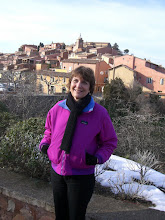
I’ve read that, upon seeing Mont Ventoux (official altitude 1909 m. or 6,273 ft.), some people immediately want to climb to the top…“because it’s there,” I suppose. Even more grueling is biking up the trails of the mountain; indeed, le géant de Provence ("the Giant of Provence") has figured prominently over the years in the legendary 2200-mile bike race known as le Tour de France. The ascent from Bédoin, considered one of the toughest in professional cycling, will be required of participants in le Tour once again this July 25th. While I would not go so far as to attempt to reach the summit of Ventoux on foot or by riding my bike, I certainly agree that there is a fascination with this peak of the Pré-Alpes, which dominates the Provençal landscape for miles around.
What attracts me the most about Mont Ventoux is its beauty, of course, as well as the richness and diversity of the forest surrounding it: la grande forêt communale. Our town library has a wonderful guide on the subject, published in 2007 and entitled Ventoux, géant de nature. Apparently, from the twelfth century onwards, wood from the mountainside was used for various purposes, including shipbuilding in Toulon, and at least 68% of the forest was depleted. Efforts at reboisement (or “reforestation”) were led by Bédoin’s nineteenth century mayor Joseph Eymard as early as 1858 and culminated in the replanting of oaks, beeches, and different types of pine trees. Cedars were brought in from the Atlas mountains in Algeria, then part of France, but, as is often the case in such situations (think "kudzu" in the southeastern U.S.), these trees from outside the area are taking over from other native species. Recognized as a réserve de biosphère by UNESCO in 1990, the forest of 6300 hectares (or over 3000 acres) and its flora and fauna will be protected for future generations.

Hikes (des randonnées pédestres) are very popular and trails (des pistes balisées) crisscross the forest; from here we have to walk gradually uphill for about a half-hour to reach the closest one. Just last Saturday we spent about an hour and a half getting an introduction to the trail just past Les Clop. Plant life on Mont Ventoux is abundant; there are more than 1200 different species. And because of the microclimates on the mountain, the vegetation is a combination of both Mediterranean and Alpine. Since it is just barely meteorological spring, not much is flowering yet, though we did see some pretty wildflowers and big patches of rosemary in bloom.
One day early in our stay here we met an older man who told us about the animal life in the forest: wild boar, mountain sheep, deer, and the like. So far, although we’ve seen and heard some birds in and around the forest, larger wild animals have eluded us. As a side note, a few times on our way back from our walks we’ve noticed one of the three remaining bergers (“shepherds”) with his dogs and flock of sheep; they were hard to miss given that les moutons are all wearing cow bells!


2 comments:
This sounds like such a beautiful place to hike. Have you heard a lot of people within the region speak of Mount Ventoux and their experiences there. I know you mentioned that the library had some literature regarding the mountain and its history as well as the animals and vegetation that reside there. Do you know if the mountain produces any food that is sold as far as cheese and or meat because you mentioned that you witnessed le moutons with cowbells.
Sorry, I don't know about foods produced on the mountain. We did drive over the top of it to Malaucene and didn't see much in terms of flocks of animals or food growing.
Post a Comment